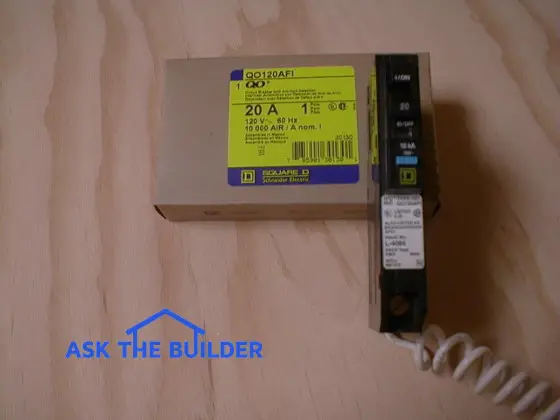Arc Fault Circuit Breakers

The arc-fault breakers have a very important pigtail wire that gets connected to the neutral / ground bar in the panel. The white neutral wire of the circuit actually connects to a screw on the breaker. Tighten the screws tight or you can have electrical panel arcing that can cause a fire!
Arc Fault Circuit Breaker TIPS
- Special circuit breakers designed to prevent fires
- Arc faults are different from ground faults - don't confuse them
- WATCH house fire arc fault breaker video below
- Match the breaker to wire gauge
- CLICK HERE to Get Tim's FREE & FUNNY Newsletter!
DEAR TIM: There was a house fire on our street last week. The fire investigators traced the cause to a short in an electrical wire.
I'm terrified that a fire can start in my own home without warning. Why didn't the person's circuit breaker trip as soon as the wire shorted?
Is there a way to prevent fires caused by short circuits in electrical wiring? Laura M., Bellevue, PA
DEAR LAURA: Your neighbor's fire was just one of the 100-plus electrical fires that happen each day in the USA.
Electrical Fires Are Evil
These fires cause hundreds of millions of dollars in damage, injure thousands of people and are responsible for the deaths of hundreds of people each year. I can see why you're terrified.
Don't Discriminate
Ask any firefighter and he will tell you that electrical fires are non-discriminatory. They can strike anywhere and at any time.
Electrical fires happen in cheap housing and in mansions of the wealthy. These fires don't care who they affect and they love striking in the middle of the night when all are asleep.
Electrical House Fire VIDEO
The house just up the street from mine caught fire in the middle of the night. It was caused by an electrical arc. A simple circuit breaker designed to sense arcs could have PREVENTED THE FIRE. WATCH this video:
Free & Fast Bids
Shorts Are Miniature Lightning Bolts
The electrical shorts that cause these fires produce arcs. These miniature fireworks create sparks and temperatures that approach 10,000 F.
This intense heat can rapidly ignite plastic insulation, wood, carpeting or any other combustible material in the vicinity of the arcing wires.
Brittle Insulation & Extension Cords
Arcs happen frequently in appliance electrical cords where insulation has become brittle or is cracked. Hidden wires behind walls nicked by nails or pinched by fasteners can also be sources of sinister arcing.
Loose Connections
Loose connections where wires are attached to switches and outlets are often arc hot spots. Wires can come loose on outlet screws by themselves from repeated heating and cooling.
Appliances that use lots of electricity should be checked for loose connections on a regular basis.
Not All Breakers Sense Arcs
The traditional circuit breakers in your neighbor's house didn't prevent the fire for a simple reason. They're not designed to sense arc faults.
Traditional circuit breakers are actually designed to protect just the wire behind the walls and the switches and outlets that they're connected to.
Regular circuit breakers are designed to trip when they sense a short that causes a massive surge of electricity coursing through a circuit. They'll also trip when too much electricity passes through the circuit. The more electricity that passes back and forth creates friction along the wire and causes a heat buildup within the breaker.
Thin Extension Cords
Traditional breakers are not designed to protect lightweight appliance wires and extension cords that are plugged into wall outlets. These extension cords are a lighter gauge wire and will heat up long before the circuit breaker senses there's an issue.
This is why extension cords are the bane of firefighters. Talk to seasoned firefighters and most will tell you extension cords should be outlawed.
New Arc-Fault Breakers
Fire-producing arcs can occur in wiring before traditional breakers react. Electrical manufacturers recognized this problem and decided to attempt to stop as many of these electrical fires as possible.

Arc fault breakers are readily available. Match the size to the wire gauge. CLICK THE IMAGE TO ORDER ARC FAULT BREAKERS FOR YOUR HOME.
The result of the hard work of many is a new arc-fault circuit interrupter breaker. These devices work and act like a traditional circuit breaker except that they are smarter.
Many of these new devices contain small filters and logic devices that allow them to sense an arc just as it is about to produce the sparks and intense heat. If arcing conditions are present, then the breaker trips instantaneously.
Arc Fault Is Different From Ground Fault
Don't confuse these devices with the personal protection ground fault circuit interrupters (GFCI) that have been around since the 1970s. The GFCI circuit breakers, at the present time, don't have the capability to sense arcs.
New In 1999
The new arc fault circuit breakers are identified in section 210-12 of the 1999 edition of the National Electric Code. Beginning January 1, 2002, they were required to protect branch circuits that serve residential bedrooms.
These areas of the house have been identified as the source of many electrical arc-related fires.
State & Local Requirements
The state of Vermont decided to take a slightly more aggressive stance when the arc-fault breakers became available. They required that these new life saving circuit breakers be used in all circuits that feed residential living areas. Their regulation went into effect on January 1, 2001.
Available Everywhere
These new arc fault breakers can be purchased now in every state in the USA. The new arc fault breakers cost about $25 - $50 each depending upon manufacturer, but it is a very small price to pay for peace of mind. An experienced electrician can install a new arc fault breaker in a matter of minutes. It actually takes longer to remove and replace the cover to the circuit breaker panel than it does to switch out the breaker.
Column 320
5 Responses to Arc Fault Circuit Breakers